‘Us’ serves scares, but still falls behind ‘Get Out’
Adelaide (Lupita Nyong’o) fights to keep Jason (Evan Alex) and Zora (Shahadi Wright Joseph) safe in Jordan Peele’s second film, “Us.”
March 28, 2019
Jordan Peele surprised and profoundly disturbed both casual moviegoers and die-hard cinephiles alike with his 2017 directorial debut “Get Out,” a commentary on the dimensions of racism masked within many white, liberalist subcultures in America. With his second film “Us,” Peele has taken a far more ambitious step to tackle a problem rooted in America’s historical identity as an oppressor — perhaps too ambitious.
“Us” tells the story of Adelaide Wilson (Lupita Nyong’o) and a traumatic event from her childhood that comes back to haunt her. Adelaide and her parents spent a night in 1986 walking down the Santa Cruz boardwalk, but unbeknownst to her parents, she wanders off onto the beach where she found an eerie hall of mirrors attraction. What she found in the hall of mirrors is something inconceivable: a little girl, identical to her in appearance, staring right back at her with an ominous grin.
Skip to present day — Adelaide and her family, including her husband Gabe (Winston Duke), her daughter Zora (Shahadi Wright Joseph) and her son Jason (Evan Alex), decide to vacation in Santa Cruz and stay at Adelaide’s old home. As they settle in, weird coincidences start occurring related to Adelaide’s repressed memory of the boardwalk incident.
After an uneasy day at the beach, Adelaide spots a sinister family of four, clad in crimson red garments, wielding razor-sharp gold shears, standing together in her driveway in the dead of night. But this is no ordinary family. As they step into the light, we see that they are uncannily identical to the Wilson family. These doppelgangers hold the family hostage in their home, revealing to them that an invasion is coming. This moment is one of the most chilling in the film.
Despite the bizarreness of the situation, there seems to be a different, mysterious tension permeating between Adelaide and her ragged-looking doppelganger, Red. Unlike the other doppelgangers, Red is more emotive and can speak, but she also has a secret grudge against Adelaide that isn’t fully clear, until the ending reveals the true nature of the situation and the condition of the doppelgangers, who identify as “the tethered.”
“Us” is a film that is ripe with allegorical references and metaphors. However, at its core, the story aims to characterize the subservient, discarded population of “the tethered,” forced to feed on raw rabbit meat and live in confinement.
Oppression has persisted throughout the history of American society, whether it be for one’s race, ethnicity, religion, sexuality or economic status. With this film, Peele goes beyond the scope of race-related commentary in “Get Out” to make a statement about large-scale, systematic oppression and the neglect of the underprivileged masses, who gain a sort of second-class citizenship.
Peele is very on-the-nose with this message, even including a scene where Adelaide asks the doppelgangers who they are, to which Red plainly responds, “We are Americans.” This message becomes even more apparent when we learn of the true nature of Adelaide and Red’s relationship.
While watching “the tethered” slowly usurp their privileged surface-dwellers, viewers will be reminded of the 1956 classic, “Invasion of the Body Snatchers.” In many ways, “Us” feels like a renovated adaptation of it. Both, of course, involve the invasion of clones who attempt to take over their real-life counterparts, but there is also an underlying point to be made about the internal condition of American society.
But the narrative of “Us” is riddled with too many plot holes and complexities that leave far too much open for creative interpretation. By the end of the film, Peele leaves us with more questions than we began with, and it’s a bit overwhelming to try to make sense of the story for what it is. It’s obvious that Peele wants the audience to focus on the implicit message rather than the canon of the story, but if you do start to think more deeply about the plot, the commentary seems to make less sense.
One of the best aspects of “Us” is the visually stunning cinematography and shot composition. Some of the stills in this film gave me goosebumps, simply from from the manipulation of lights and shadows that seem to accentuate the eyes and cheekbones of shadowy figures. Peele even borrows Kubrick’s style of symmetry from “The Shining” in his hallway longshots, which work very well in emphasizing the mania-inducing environment that “the tethered” inhabit. These shots have an unnerving characteristic, not just from the unnaturally pristine condition of the shot, but also from the lost sense of time and distance we feel.
Considering the absurdly high precedent Jordan Peele set with “Get Out,” which propelled him to the status of visionary auteur, there was bound be high expectations for his second film. “Us” is a good film, but it seems to be caught in the shadow of its more masterfully crafted predecessor.








